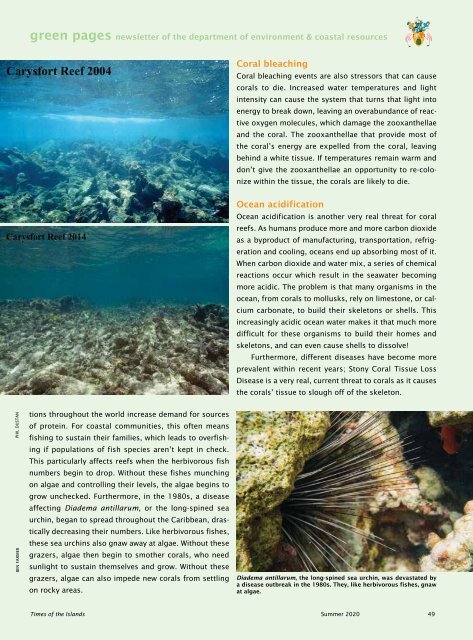Times of the Islands Summer 2020
Presents the "soul of the Turks & Caicos Islands" with in-depth features about local people, culture, history, environment, businesses, resorts, restaurants and activities.
Presents the "soul of the Turks & Caicos Islands" with in-depth features about local people, culture, history, environment, businesses, resorts, restaurants and activities.
Create successful ePaper yourself
Turn your PDF publications into a flip-book with our unique Google optimized e-Paper software.
green pages newsletter <strong>of</strong> <strong>the</strong> department <strong>of</strong> environment & coastal resources<br />
Coral bleaching<br />
Coral bleaching events are also stressors that can cause<br />
corals to die. Increased water temperatures and light<br />
intensity can cause <strong>the</strong> system that turns that light into<br />
energy to break down, leaving an overabundance <strong>of</strong> reactive<br />
oxygen molecules, which damage <strong>the</strong> zooxan<strong>the</strong>llae<br />
and <strong>the</strong> coral. The zooxan<strong>the</strong>llae that provide most <strong>of</strong><br />
<strong>the</strong> coral’s energy are expelled from <strong>the</strong> coral, leaving<br />
behind a white tissue. If temperatures remain warm and<br />
don’t give <strong>the</strong> zooxan<strong>the</strong>llae an opportunity to re-colonize<br />
within <strong>the</strong> tissue, <strong>the</strong> corals are likely to die.<br />
Ocean acidification<br />
Ocean acidification is ano<strong>the</strong>r very real threat for coral<br />
reefs. As humans produce more and more carbon dioxide<br />
as a byproduct <strong>of</strong> manufacturing, transportation, refrigeration<br />
and cooling, oceans end up absorbing most <strong>of</strong> it.<br />
When carbon dioxide and water mix, a series <strong>of</strong> chemical<br />
reactions occur which result in <strong>the</strong> seawater becoming<br />
more acidic. The problem is that many organisms in <strong>the</strong><br />
ocean, from corals to mollusks, rely on limestone, or calcium<br />
carbonate, to build <strong>the</strong>ir skeletons or shells. This<br />
increasingly acidic ocean water makes it that much more<br />
difficult for <strong>the</strong>se organisms to build <strong>the</strong>ir homes and<br />
skeletons, and can even cause shells to dissolve!<br />
Fur<strong>the</strong>rmore, different diseases have become more<br />
prevalent within recent years; Stony Coral Tissue Loss<br />
Disease is a very real, current threat to corals as it causes<br />
<strong>the</strong> corals’ tissue to slough <strong>of</strong>f <strong>of</strong> <strong>the</strong> skeleton.<br />
PHIL DUSTAN<br />
BEN FARMER<br />
tions throughout <strong>the</strong> world increase demand for sources<br />
<strong>of</strong> protein. For coastal communities, this <strong>of</strong>ten means<br />
fishing to sustain <strong>the</strong>ir families, which leads to overfishing<br />
if populations <strong>of</strong> fish species aren’t kept in check.<br />
This particularly affects reefs when <strong>the</strong> herbivorous fish<br />
numbers begin to drop. Without <strong>the</strong>se fishes munching<br />
on algae and controlling <strong>the</strong>ir levels, <strong>the</strong> algae begins to<br />
grow unchecked. Fur<strong>the</strong>rmore, in <strong>the</strong> 1980s, a disease<br />
affecting Diadema antillarum, or <strong>the</strong> long-spined sea<br />
urchin, began to spread throughout <strong>the</strong> Caribbean, drastically<br />
decreasing <strong>the</strong>ir numbers. Like herbivorous fishes,<br />
<strong>the</strong>se sea urchins also gnaw away at algae. Without <strong>the</strong>se<br />
grazers, algae <strong>the</strong>n begin to smo<strong>the</strong>r corals, who need<br />
sunlight to sustain <strong>the</strong>mselves and grow. Without <strong>the</strong>se<br />
grazers, algae can also impede new corals from settling<br />
on rocky areas.<br />
Diadema antillarum, <strong>the</strong> long-spined sea urchin, was devastated by<br />
a disease outbreak in <strong>the</strong> 1980s. They, like herbivorous fishes, gnaw<br />
at algae.<br />
<strong>Times</strong> <strong>of</strong> <strong>the</strong> <strong>Islands</strong> <strong>Summer</strong> <strong>2020</strong> 49

















